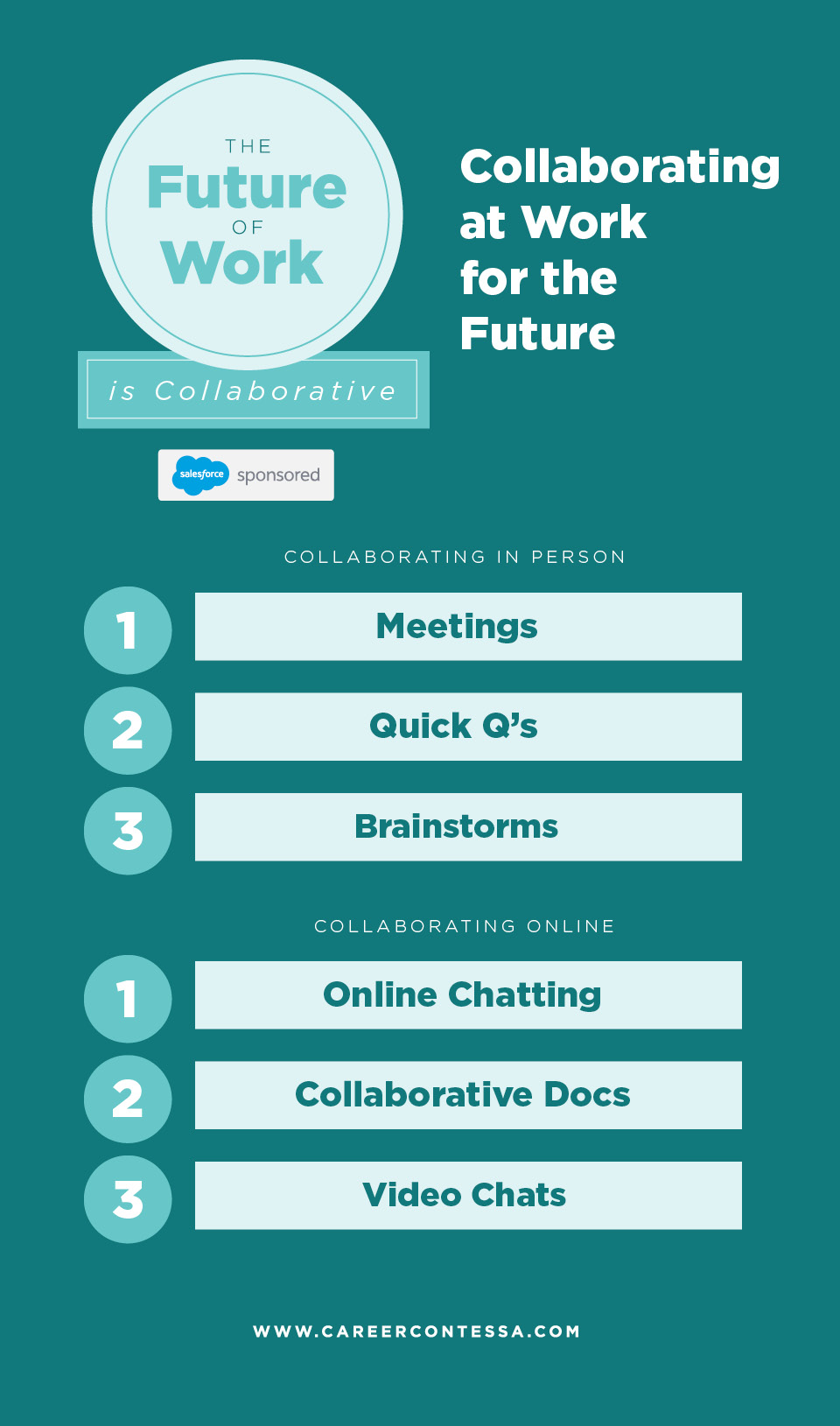The Future of Work series is sponsored by Salesforce.
What increases employee satisfaction, improves company efficiency, and boosts productivity levels?
Collaboration.
Collaboration is essential to any company. It helps produce quality ideas, quality work culture, and quality employee satisfaction. The ability to listen to others, share your own ideas, and foster productive dialogue is a skill every employee wants—and that every company should look for in its employees. But collaboration in the workplace is two-fold. Employees must facilitate the actual collaborative processes, but the company is responsible for creating a culture in which collaboration can happen—they must provide the opportunities.
A study by Salesforce actually found that 86 percent of employees and executives cite lack of collaboration or ineffective communication for workplace failures—meaning collaboration, and communication, are the real keys to succeeding at work. But collaboration isn't always easy—and it's definitely not a given, especially with the rise of remote workers.
Currently, 4.3 million employees (3.4 percent of the workforce) work from home at least half the time. And as the workforce moves toward more remote, work-from-home, and flexible work schedules, collaboration becomes absolutely imperative. The future of work is flexible—
80 to 90 percent of our workforce would like to telework at least part-time, two to three days a week.
A study by Upwork found hiring managers predict that up to 38 percent of their full-time staff will be working remotely in the next decade, which means that workplaces focusing solely on traditional collaboration opportunities are going to have to adapt.
How can companies promote collaboration, while maintaining quality work culture, flex scheduling, and/or remote employees.
You find the balance. In-person collaboration will happen when employees are in the office, for sure. It's just going to have to be balanced with online collaboration options. In workplaces where collaborative opportunities are lacking, clear communication is the first step. Communicating the delegation of tasks, the expectations of each team member, and promoting teamwork can help increase the collaborative tendencies of your company.
Here are a few tips for collaborating in the office—for the now, and for the future.
Collaborating at Work For the Future
Collaborating in Person
Meetings
The classic collaboration. Typically, meetings have some sort of presentation to begin with, and then an opportunity for discussion and collaboration immediately following. To facilitate dialogue during a meeting, we recommend including an agenda with your meeting request, so your attendees can look it over, and set up any preliminary questions they might have, in addition to their follow-ups that will come up during the meeting itself.
Quick Q’s
We're big fans of a quick question. If you’re in the same vicinity as your coworkers, you’ve probably come into contact with the “quick q.” It’s a great way to get collaborative for a second, before carrying on with your work. This is an opinion question like, “Hey Aliya, for this video, should we include statistics throughout, or only in the introduction?” The downside to this form of collaboration is that it’s possible you’re interrupting your coworker from doing their very important work—and if you don’t want to wait patiently, staring at them until they take their headphones out—this might not be a great way to collaborate.
Brainstorms
These are less formal than a traditional meeting, and they’re typically less structured. It’s a spit-balling session, essentially. You get the brains in the room that need to be there—for whatever pitch you’re creating or problem you’re solving—and you just get to work suggesting ideas or solutions. It’s as simple as that. In an open, trusting environment, this type of collaboration,
in my opinion, is the most fun. You get to build off of each other—and the end result is often better than anything you could have come up with on your own.
Collaborating Online
Online Chats
We love a good online chat here at the Career Contessa office. Especially when we work from home on Fridays, it keeps us all organized and able to communicate and collaborate in an efficient way. If your office isn't conducive to the "quick q" method of collaboration we touched on earlier, or if you want to do that in a more polite way, chat is the way to go. Platforms like Slack,
Chatter, or Google chat keep your communication organized and allow for a remote collaboration if needed.
Docs
Editing a document with multiple people at the same time? What a dream. Collaborative docs like
Quip or Google Docs allow any person, from anywhere, to work on a project. You can track edits your coworkers make, add comments or suggestions to ask questions or make changes, and all of this is done in a way that your entire team can have access to. If you're working on a project with partners outside of your organization, they can work in the same document, too.
Video Chats
Video chats are a step up from phone calls—this form of collaboration still allows you to pick up on your audience's facial expressions and body language. You can also do screen shares, which allow your coworkers or partners to see exactly what's happening on your screen, with your thought process. Video chats can help substitute traditional presentations, in that a person can technically hold a meeting or give a presentation from anywhere in the world.
Collaboration has never been this easy.
Do you want to play a role in the future of work? Check out open roles at Salesforce and learn all about their awesome company culture here.
The Future of Work series is sponsored by Salesforce.










